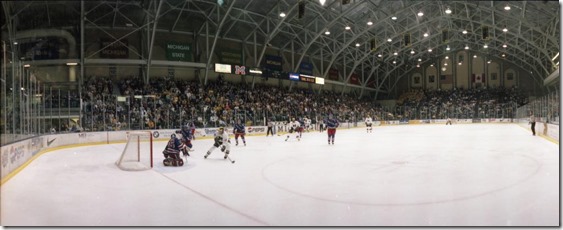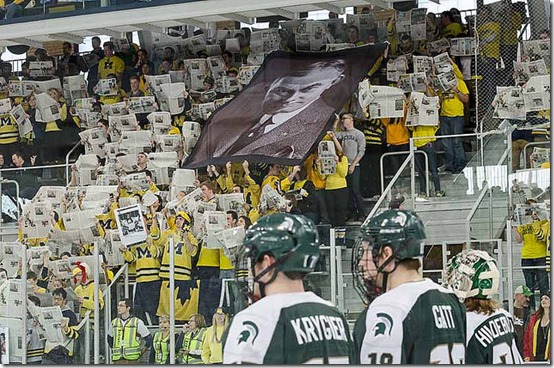oral-history
Previously: Part One, Part Two, Part Three
[West Regional vs NoDak, 1998/Kalmbach via Bentley Historical Library]
The story is almost too perfect. You expect the details of a hockey story to flow from odd angles, to be all jagged edges and shoulders and elbows and yet this story is writerly and neat and almost formulaic. It follows the kind of structure script writers teach in their intro film classes: the protagonist runs through the gauntlet and passes a test that changes them, then uses their newly girded spirit to pass the ultimate test and reap a reward barely fathomable at the start of the journey. From humble beginnings, etc.
The necessity of icing an unusually high number of freshmen dampened expectations at the start of Michigan’s 1997-98 season, but there were enough upperclassmen remaining—Marty Turco, Bill Muckalt, Matt Herr, and Bobby Hayes, to name a few—to keep them from falling off precipitously. Yes, skating four freshmen defensemen was different, but close games can be won with a Hobey Baker finalist, Muckalt, leading the offense and one of the best goaltenders in the country, Turco, as the last line of defense.
And close games—one-goal games, to be precise—soon became Michigan’s calling card. Entering the NCAA Tournament, sixteen of their 42 contests had been one-goal games, including two of the games that got them to the GLI final and two of the games that got them to the CCHA Tournament final. The GLI and CCHA finals against Michigan State and Ohio State, respectively, left their mark. Both were losses and both snapped long streaks for the Wolverines, who had won two straight CCHA tournaments and nine straight Great Lakes Invitationals.
Those losses, however, ended up helping Michigan in their NCAA Tournament seeding. Not only were they placed at the West Regional, which happened to be held at Yost this season, but they were seeded third. This put them on the opposite side of the bracket from Michigan State, the one-seed and no. 1 overall team in the nation, and Ohio State, the no. 6 team in the country yet somehow the four-seed. Two teams they’d had a problem with all year, their two in-conference archrivals, were on a collision course.
That didn’t mean that Michigan’s road to the Frozen Four would be easy, though. North Dakota, the defending national champion and no. 2 team in the USCHO poll, was waiting in the wings. Michigan would have to fight the temptation to look ahead to that game and first dispatch six-seed Princeton, which made the Tournament by winning the ECAC and was listed last in USCHO poll’s “others receiving votes” section.
-------------------------------
Mel Pearson, assistant coach: Weird game. It just seemed like we were either looking ahead or...there was something going on in that game and we just didn’t have it and there was nothing going right for us. I think part of that was Princeton but I don’t think we respected them enough as a team. They worked hard and they didn’t give us anything and I think we just thought we were going to come in and throw down our sticks and they were going to fade away and we’d blow them out and go into the regional final but it didn’t work out that way.
Innocent play from the sidewall down near the zamboni. I can’t even remember who threw it at the net but somehow it hit a couple guys in front and went right between the goalie’s legs. We didn’t even have a player in front of the net. I think it went off of one of their players and went in the net. Once that goal went in it just seemed like, Okay, here we go. The crowd got into it a little bit. Princeton had played an absolute great road game. They didn’t let the crowd into it for the most part but once that goal went in we started to play better.
The thing I remember is it was just a weird goal, literally. One of our guys backhanded it towards the net, it hits one of their guys, a defenseman, goes off a skate between the goalie’s net and it’s in. It’s like, there’s nobody there. It’s one of the weirdest goals I’ve ever seen. Did we have anybody in front? I don’t think there was. It’s strange. It’s just like an act of the hockey gods.
[After THE JUMP: The hockey gods have a field day]
Previously: Part One, Part Two
[Yost in the late ‘90s/Kalmbach via Bentley Historical Library]
Michigan’s heralded 1993 and 1994 recruiting classes began paying dividends immediately. The 1993-94 Wolverines had three winning streaks of seven games or longer in just a 41-game season, the longest of which reached 11 games. The 1994-95 team took something of a step back—their longest winning streak was only nine games—while still winning 30 games and finishing first in the CCHA.
The most dominant streak of the decade dovetailed with the vaunted recruits becoming upperclassmen. The nature of collegiate hockey scheduling left its mark on previous winning streaks; many took place across multiple road series with neutral-site games sprinkled in. In 1995-96, however, Michigan’s offense hit its stride just as the Wolverines returned home for a six-game homestand at the beginning of January. Their eight-game winning streak started with a GLI title that they took by a combined score of 9-2. They put up even gaudier numbers in front of their own crowd, averaging 9.6 goals per game over six home contests.
The season ended with Michigan’s first national championship in 32 years; before they got there, goalies were pulled, the wooden bleachers creaked and swayed, the crowd beyond the students got involved, and for opponents, the ghosts of Yost were growing louder.
-------------------------------
Brendan Morrison, forward (1993-97): That was an incredible stretch. I think we averaged that month or six weeks or whatever it was, we averaged something ridiculous like 8.7 goals a game or something like that. [Ed. A—They averaged 7.6 goals per game over the ten games from the GLI at the end of December through the end of January and the aforementioned 9.6 goals per game counting just the six-game January homestand.] Just absurd. I know every single home game we played, the other team’s goalie was pulled at some point. I don’t think it was a very fun place for other teams to come in and play. They knew they were walking into kind of the lion’s den there; we were rolling and scoring a bunch of goals. It was intimidating. I remember other programs coming out and verbalizing that it was a tough place to play. It was difficult. It’s almost like with our fans and playing in that arena, it was like you were up 1-0 or 2-0 before the game even started.
Marty Turco, goaltender (1994-98): For me, having us rolling teams, you look at the scores and you’re like rolling teams, yeah, 8-3, 7-2, 10-4. You’re like, Alright. Everybody else was happy except for Red because Red was like, “No one cares because we won and we dominated but how about those two you let in there?” I might not have been needed as much to have the game on the line early and mid-year, but he wanted to make sure I was the guy he thought I was at the end of the year. So it wasn’t all hunky-dory during that year [1995-96] for me in particular but it was huge in terms of growth.
Tim Carmody, student season ticket holder: It was exciting. It was definitely very relevant. People would go all the time. People would show up a little bit later for parties on hockey nights.
[After THE JUMP: the crowd’s creativity, the environment’s advantage, and the quirks of an old barn]
Previously: Part one
[Bill Rapai]
The time blocked out on Red Berenson’s schedule for handing out free tickets could be reallocated to recruiting by 1993. Michigan had won or tied 56 of their last 62 home games by the beginning of the 1993-94 season, was riding a three-year NCAA Tournament streak, and had finished no worse than second in the CCHA each of the past three seasons.
The success of the team fueled Yost’s atmosphere, and the atmosphere helped reel in recruits; Michigan’s 1993 recruiting class featured future Hobey Baker winner Brendan Morrison as well as John Madden, Jason Botterill, Mike Legg, and Warren Luhning. The recruiting success continued in 1994, as Berenson signed Marty Turco, Bill Muckalt, and Matt Herr. Stories of Yost’s unmatched gameday environment spread by word of mouth and students were soon filling the entire east side of Yost. The means for procuring tickets changed drastically as the one-time Diag freebie became one of the hottest tickets in town; students camped out as more highly-touted recruits came in.
Brendan Morrison, forward (1993-97): My freshman year we had a great team and were competing for the national championship and every single night we went into that arena and played at home it was sold out and the students led the charge. You look at the architecture of the rink and you read about the history of the field house and how it evolved over the years to where it is now or where it was my senior year— I remember students would sleep outside the Michigan Union there for two nights in order to get season tickets. When you walked by there as a player and you saw the commitment that your fellow students were willing to make in order to come and watch your team play, it was truly a special thing to be able to go out there and play in front of them and it really made you understand how special a place Yost is.
Roger Spurgeon, student season ticket holder: I met these guys and we made friendships our freshman year, so our sophomore year I wouldn’t be surprised if it was me who said, “Hey, let’s go get season tickets.” They sold them at the Union and I don’t think we actually camped out. I think we went there at maybe 6 AM.
Scott Spooner, student season ticket holder: Yeah, I think the first year we were like “Let’s get there early” so we got there at like 6 AM.
Spurgeon: Yeah, like 6 AM, and there were maybe 50 people in front of us. I kind of remember that season tickets were about $60 and we got a free hockey jersey. It had “Subway” written on the back. It was a cheap reproduction hockey jersey, it wasn’t anything fancy. I think the next couple years they gave us sweatshirts. Like, nice sweatshirts as incentives to buy season tickets.
Spooner: That still said “Subway” on the back.
Spurgeon: We didn’t care. We got freebies, so we didn’t care if it said “Subway” or not.
Megaphone Man, student season ticket holder: Demand was high. You got a season sweatshirt when you camped out and put in your order for tickets. I remember they were sponsored by Subway, so they were kind of like a must-have item, kind of like they do with the football shirts and the Maize Rage shirts. Before they started doing it on a regular basis for the other sports, I think hockey was the only one really doing it at the time.
[After THE JUMP: fandom expands, everyone dances, and the rules of the rule-free student section]



20